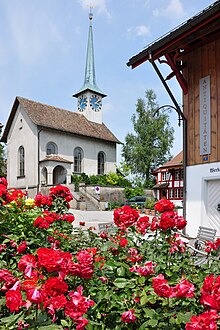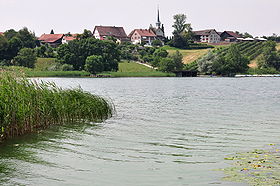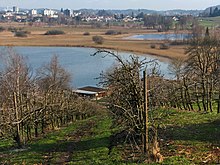Sea trenches
| Sea trenches | |
|---|---|
| State : |
|
| Canton : |
|
| District : | Hinwil |
| BFS no. : | 0119 |
| Postal code : | 8607 Aathal Sea Trenches |
| Coordinates : | 700 774 / 244495 |
| Height : | 536 m above sea level M. |
| Height range : | 496-583 m above sea level M. |
| Area : | 3.77 km² |
| Residents: | 1443 (December 31, 2018) |
| Population density : | 324 inhabitants per km² |
|
Proportion of foreigners : (residents without citizenship ) |
16.7% (December 31, 2018) |
| Mayor : | Marco Pezzatti ( FDP ) |
| Website: | www.seegraeben.ch |
|
View over the Pfäffikersee |
|
| Location of the municipality | |
Seegräben is a municipality in the district of Hinwil in the canton of Zurich in Switzerland .
coat of arms
- Divided, above a silver dugout canoe in blue, below from the division four times stiffened by gold and blue
The dugout canoe in the coat of arms is related to the pile dwellers. Jakob Messikommer (Robenhausen / Wetzikon) researched a pile dwelling settlement in the Robenhauser Ried, in the municipality of Seegräben, in 1858 and thus carried out essential basic work on pile dwelling research.
geography
The Seegräben community includes the village parts Seegräben, Aathal , Ottenhausen ZH , Steinberg, Aretshalden, Wagenburg and Sack. It is located directly at the southwest end of the Pfäffikersee in a gently rolling landscape.
Along the lakeshore there are some large reed areas , which are part of the nationally protected local recreation area around the lake. 49.9% of the municipal area is used for agriculture, 15.5% is covered with forest, 5.3% is traffic area and 10.4% is settlement area, 10.4% is water.
The topography is shaped by the moraines of the Linth glacier, which extended over the area during the last ice age. The Aabach flows through a valley on whose steep flanks the typical Nagelfluh (Aathal gravel) shows. There are numerous smaller and larger grottos in it. The largest of these, the so-called French Cave, is about 15 meters long and up to 2 meters high.
population
On December 31, 2019, 1,426 people lived in the Seegräben community.
religion
On December 31, 2019, 40.88 percent of the population belonged to the Evangelical Reformed Church and 18.37 percent to the Roman Catholic Church .
politics
The mayor is Marco Pezzatti ( FDP ) (as of 2014). His predecessor was Marlis Schmalzl ( SVP ) from 2010 to 2014 . Pierre Derron ( FDP ) was mayor until 2010.
Legislative is the municipal assembly.
| Members of the Seegräber parish council (2018-2022) | |||
|---|---|---|---|
| Surname | Taking office | Department | Political party |
| Marco Pezzatti | 2010/2014 | Mayor / Presidential and Civil Engineering | FDP |
| Michael Berchtold | 2010 | security and environment | independent |
| Philipp Küng | 2014 | Education and youth | independent |
| Katharina Hefti | 2010 | Society and Health | independent |
| Reto Gasser | 2018 | Building construction | SVP |
| Nicole Fuchs | 2015 | Social | independent |
| Reto Steinmann | 2014 | Finances | FDP |
Elections 2019
National Council : SVP : 34.41%, Greens : 15.91%, SP : 13.21%, glp : 12.32%, FDP : 11.74%, EVP : 4.27%, CVP : 2.53% , BDP : 2.15%, EDU 1.37%, IP: 0.71%, AL: 0.68%, SD: 0.4%, the good guys: 0.26%, pirates : 0.02%, ECO: 0%, Sarantidis: 0%, up !: 0%.
Cantonal Council : SVP : 33.28%, FDP : 18.76%, Greens : 14.56%, glp : 11.16%, SP : 10.2%, EVP : 5.02%, CVP : 2.07% , BDP : 1.85%, EDU: 1.75%, AL: 1.36%.
economy

In the 19th century the textile industry in the Aathal provided an economic boom. At that time the community changed from a farming village to an important industrial location. Agriculture lost its importance compared to industrial production. Today, the community is valued above all as a residential community that has good transport links to the rail network and the cantonal road network to Zurich. The S-Bahn Zurich serves the Aathal station with the S 14 Affoltern a. A. - Altstetten - Zurich HB - Oerlikon - Wallisellen - Hinwil . Starting in 2020, a 2-year pilot test of the 846 bus will run every half hour between Uster, train station and Seegräben, parish hall from May to October on the weekends.
Postbus line 909 used to run very irregularly from the parish hall to the SBB train station.
However, with the closure of the post office and the manned train station, the community has lost some of its infrastructure.
The Sack part of the village also houses the Villa RA school home.
Attractions



The Aathal dinosaur museum in the village of the same name is very well known , as is the Römerbrünneli (city of Uster). The community also houses a section of the Zürcher Oberland industrial path. The village of Seegräben is of supraregional importance.
In the village part of Sack there are remains of an earlier protective wall, the so-called Heidenburg, which is acutely threatened by the planned motorway construction. In addition, finds were made in Ottenhausen, which indicate the existence of a Roman manor and a Roman road, which were presumably connected with the Irgenhausen Roman fort .
In the center of the village, right next to the church, is the Jucker family's farm, where the largest pumpkin exhibition in Switzerland takes place from late August to early November. The Winter Magic Christmas Market takes place in mid-November along Dorfstrasse.
The industrial plants in Aathal are listed and, thanks to their good condition, are important witnesses to the economic heyday of the Zurich Oberland in the 19th and 20th centuries.
The Pfäffikersee, on which Seegräben is located, is a popular excursion destination and recreation area thanks to its nationally protected reed areas.
Culture
Organ cycles and other concerts take place in the Seegräben church (see the website of the Seegräben community).
Personalities
- Edwin Messikommer (1891–1983), algae researcher
- Bruno Boesch (1911–1981), Professor of German Studies at the University of Freiburg i. Br.
literature
- Edwin Messikommer: History of the Seegräben community. NZN Buchverlag, Zurich 1973.
- Seegräbner messenger. Since 1978. Frequency: monthly.
- Hans-Peter Bärtschi: 100 years of the Streiff AG spinning mill, Aathal, 1901–2001. Streiff AG spinning mill, Aathal 2001.
- Hans Schöni: Bruno Boesch 1991–1981. A brief account of life and work. School maintenance, Seegräben 1995.
- Hans Schöni: Bruno Boesch and the challenge of the 68s. His time as rector at the Albert-Ludwigs-Universität Freiburg i.Br. 1968-1970. School maintenance, Seegräben 1998.
- Werner Messikommer: 100 years of the Aathal-Seegräben gymnastics club. Jubilee publication 1897–1997. Gymnastics Club, Seegräben 1997.
- S-Bahn Zurich: Double lane Wetzikon - Aathal, information on commissioning. SBB, Zurich 1990.
- Bruno Boesch, Werner Messikommer and others: 200 years of the Seegräben tithe plan. Seegräben 1981. Supplement: The reason for cracking the toe in Seegräben to serve the Rütj office […] (1781).
- Markus Steinmann: Settling in Seegräben. Thesis. Architecture department at ETH Zurich, 1980.
- Brunhild Hammer: Pestalozzihaus Schönenwerd of the City of Zurich in Aathal-Seegräben. Building Department, Zurich 1976.
- G. Strickler: History of the rule Grüningen including the 16 communities [...] Seegräben [...]. That is the story of the Zurich Oberland and its relationship with the city of Zurich and the lake. Orell-Füssli, Zurich 1908.
- Natalie Streiff: fiber to thread, the production of cotton yarn in the last spinning mill in the Zurich Oberland. Streiff AG spinning mill, Seegräben 2010.
- Hermann Fietz: The art monuments of the canton of Zurich. Volume II: The districts of Bülach, Dielsdorf, Hinwil, Horgen and Meilen. (= Art Monuments of Switzerland. Volume 15). Edited by the Society for Swiss Art History GSK. Bern 1943. DNB 365803049 .
- Peter Niederhäuser: Celts, pumpkins and monastery villages, 800 years of Seegräben. Chronos Verlag, Zurich 2019.
Web links
- Official website of the Seegräben community
- Statistical data for the Seegräben community
- Ueli Müller: Seegräben. In: Historical Lexicon of Switzerland .
Individual evidence
- ↑ Permanent and non-permanent resident population by year, canton, district, municipality, population type and gender (permanent resident population). In: bfs. admin.ch . Federal Statistical Office (FSO), August 31, 2019, accessed on December 22, 2019 .
- ↑ Data on the resident population by home, gender and age (community profile). Statistical Office of the Canton of Zurich, accessed on December 22, 2019 .
- ^ Portrait of the municipality of the Canton of Zurich. at: statistik.zh.ch (accessed on March 29, 2016).
- ↑ Provisional population data as of the end of 2011. from: statistik.zh.ch (accessed on February 27, 2012)
- ↑ FDP and SVP argue about the presidium. on: tagesanzeiger.ch
- ↑ Pumpkin Exhibition. In: juckerfarm.ch. Retrieved August 7, 2013 .







